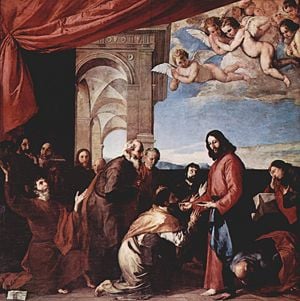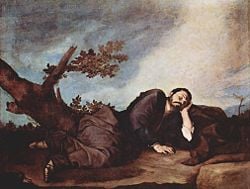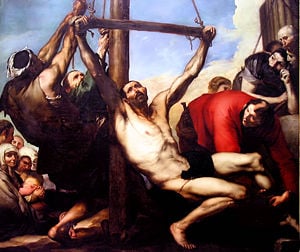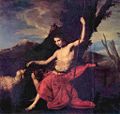Ribera, Jusepe de
Andy Wilhelm (talk | contribs) |
Andy Wilhelm (talk | contribs) m (Protected "Jusepe de Ribera": Copyedited [edit=sysop:move=sysop]) |
||
| Line 1: | Line 1: | ||
| − | {{ | + | {{Copyedited}}{{approved}}{{images OK}}{{Ready}}{{Contracted}}{{Started}}{{Submitted}}{{Paid}} |
{{epname|Ribera, Jusepe de}} | {{epname|Ribera, Jusepe de}} | ||
[[Image:José de Ribera 006.jpg|thumb|300px|right|''The Apostles Communion'' (1651)]] | [[Image:José de Ribera 006.jpg|thumb|300px|right|''The Apostles Communion'' (1651)]] | ||
| − | '''Jusepe de Ribera''' (January 12, 1591 – 1652) was a [[Spain|Spanish]] [[Tenebrism|Tenebrist]] [[Painting|painter]] and [[printmaker]], also known as '''José de Ribera''' in Spanish and as '''Giuseppe Ribera''' in Italian. He was also called by his contemporaries and early writers '''Lo Spagnoletto''', or "the Little Spaniard." | + | '''Jusepe de Ribera''' (January 12, 1591 – 1652) was a [[Spain|Spanish]] [[Tenebrism|Tenebrist]] [[Painting|painter]] and [[printmaker]], also known as '''José de Ribera''' in [[Spanish language|Spanish]] and as '''Giuseppe Ribera''' in [[Italian language|Italian]]. He was also called by his contemporaries and early writers '''Lo Spagnoletto''', or "the Little Spaniard." |
Ribera was a leading painter of the Spanish school, although his mature work was all done in [[Italy]]. Ribera's works were Spanish influenced in content and Italian inspired in technique. He became a success using [[Tenebrism]], from the Italian ''tenebroso'' ("murky"), a style of painting using violent contrasts of light and dark. A heightened form of [[chiaroscuro]], it creates the look of figures emerging from the dark. | Ribera was a leading painter of the Spanish school, although his mature work was all done in [[Italy]]. Ribera's works were Spanish influenced in content and Italian inspired in technique. He became a success using [[Tenebrism]], from the Italian ''tenebroso'' ("murky"), a style of painting using violent contrasts of light and dark. A heightened form of [[chiaroscuro]], it creates the look of figures emerging from the dark. | ||
| − | Ribera was inventive in his subject matter, ranging through [[visionary]] spectacles, [[Bible|biblical]] themes, genre, [[portrait]]s, [[myth]]ological subjects, and portraits of [[Asceticism|ascetics]] and [[penitent]]s. His use of line, color and shadow emulated the Italianate [[Baroque]] style of [[Caravaggio]].<ref>Heineman, | + | Ribera was inventive in his subject matter, ranging through [[visionary]] spectacles, [[Bible|biblical]] themes, genre, [[portrait]]s, [[myth]]ological subjects, and portraits of [[Asceticism|ascetics]] and [[penitent]]s. His use of line, color and shadow emulated the Italianate [[Baroque]] style of [[Caravaggio]].<ref>Melanie Heineman, [http://www.knox.edu/x1137.xml Jusepe de Ribera: Saint Jerome] ''Knox.edu.'' Retrieved January 28, 2008.</ref> |
| − | He was one of the few | + | He was one of the few seventeenth-century Spanish artists to produce numerous [[drawing]]s, and his [[etching]]s were among the finest produced during the Baroque period. The subject of the [[martyr]]ed saint was a prevalent theme in Spanish Baroque art, which was devoted to the religious policies and goals of the [[Catholic Church]]. His paintings and prints were frequently devoted to themes of [[saint]]s and [[Religion|religious]] events reflecting the spiritual intensity and [[mysticism]] of the Spanish [[Counter-Reformation]]. |
==Early life== | ==Early life== | ||
| − | Ribera was born near [[Valencia, Spain|Valencia]], [[Spain]] at San Felipe de Játiva, now named [[Xàtiva]]. His father was a shoemaker and apparently his parents intended for him to be a scholar but he neglected these studies and is said to have apprenticed with the Spanish painter [[Francisco Ribalta]] in Valencia, although no proof of this connection exists. Longing to study art in [[Italy]], he made his way to Rome via [[Parma]], where he painted an altarpiece for the Church of San Prospero | + | Ribera was born near [[Valencia, Spain|Valencia]], [[Spain]] at San Felipe de Játiva, now named [[Xàtiva]]. His father was a shoemaker and apparently his parents intended for him to be a scholar but he neglected these studies and is said to have apprenticed with the Spanish painter [[Francisco Ribalta]] in Valencia, although no proof of this connection exists. Longing to study art in [[Italy]], he made his way to [[Rome]] via [[Parma]], where he painted an altarpiece for the Church of San Prospero in 1611, and he completed a painting on the subject of ''Jacob's Ladder'', now in the [[Prado Museum]], in [[Madrid]]. |
Ribera lived in Rome from 1613-16, on the Via Margutta, and associated with students of [[Caravaggio]], including [[Gerrit van Honthorst]] and [[Hendrik ter Brugghen]]. He then moved to [[Naples]] and remained there the rest of his life. | Ribera lived in Rome from 1613-16, on the Via Margutta, and associated with students of [[Caravaggio]], including [[Gerrit van Honthorst]] and [[Hendrik ter Brugghen]]. He then moved to [[Naples]] and remained there the rest of his life. | ||
| Line 25: | Line 25: | ||
[[Image:El martirio de San Felipe 1639 José de Ribera.jpg|thumb|300px|right|Martyrdom of [[St Philip]], 1639, [[Prado]], Madrid]] | [[Image:El martirio de San Felipe 1639 José de Ribera.jpg|thumb|300px|right|Martyrdom of [[St Philip]], 1639, [[Prado]], Madrid]] | ||
| − | The period after Osuna was recalled in 1620 seems to have been a difficult time for de Ribera. Few paintings survive from 1620 to 1626; but this was the period in which most of his best prints were produced. These were at least partly an attempt to attract attention from a wider audience than Naples. His career picked up in the late 1620s, and he was accepted as the leading painter in Naples thereafter. | + | The period after Osuna was recalled in 1620 seems to have been a difficult time for de Ribera. Few paintings survive from 1620 to 1626; but this was the period in which most of his best prints were produced. These were at least partly an attempt to attract attention from a wider audience than Naples. His career picked up in the late 1620s, and he was accepted as the leading painter in Naples thereafter. |
The [[Academy of St. Luke]] in [[Rome]] elected de Ribera to membership in 1625, and six years later he became a knight of the [[Papal]] [[Order of Christ]] of [[Portugal]], but he was unsuccessful in obtaining a coveted Spanish knighthood. | The [[Academy of St. Luke]] in [[Rome]] elected de Ribera to membership in 1625, and six years later he became a knight of the [[Papal]] [[Order of Christ]] of [[Portugal]], but he was unsuccessful in obtaining a coveted Spanish knighthood. | ||
| Line 32: | Line 32: | ||
His earliest style, founded sometimes on [[Caravaggio]] and sometimes on the wholly diverse method of [[Correggio]], can be traced to the study of Spanish and Venetian masters. Along with his massive and predominating [[shadow]]s, he retained from first to last a great strength in local coloring. His forms, though ordinary and sometimes coarse, are correct; the impression of his works gloomy and startling. | His earliest style, founded sometimes on [[Caravaggio]] and sometimes on the wholly diverse method of [[Correggio]], can be traced to the study of Spanish and Venetian masters. Along with his massive and predominating [[shadow]]s, he retained from first to last a great strength in local coloring. His forms, though ordinary and sometimes coarse, are correct; the impression of his works gloomy and startling. | ||
| − | Ribera's career in Naples is highlighted by several commissions for the [[Monastery|monastic]] complex of ''Certosa di San Martino''. Initially, from 1638 to 1643, he painted a series of [[prophet]]s for the facade interior and side chapels of the [[church]]. Later, in 1651, he completed a large picture, the ''Communion of the Apostles'', for the choir in the same church.<ref>[http://www.metmuseum.org/toah/hd/npls/hd_npls.htm Art of the Seventeenth and Eighteenth Centuries in Naples] ''Metmuseum.org.'' Retrieved January | + | Ribera's career in Naples is highlighted by several commissions for the [[Monastery|monastic]] complex of ''Certosa di San Martino''. Initially, from 1638 to 1643, he painted a series of [[prophet]]s for the facade interior and side chapels of the [[church]]. Later, in 1651, he completed a large picture, the ''Communion of the Apostles'', for the choir in the same church.<ref>[http://www.metmuseum.org/toah/hd/npls/hd_npls.htm Art of the Seventeenth and Eighteenth Centuries in Naples] ''Metmuseum.org.'' Retrieved January 28, 2008.</ref> |
In the early 1630s his style changed away from strong contrasts of dark and light to a more diffused and golden lighting. [[Salvator Rosa]] and [[Luca Giordano]] were his most distinguished followers, who may have been his pupils; others were also [[Giovanni Do]], [[Enrico Fiammingo]], [[Michelangelo Fracanzani]], and [[Aniello Falcone]]. | In the early 1630s his style changed away from strong contrasts of dark and light to a more diffused and golden lighting. [[Salvator Rosa]] and [[Luca Giordano]] were his most distinguished followers, who may have been his pupils; others were also [[Giovanni Do]], [[Enrico Fiammingo]], [[Michelangelo Fracanzani]], and [[Aniello Falcone]]. | ||
| − | Among Ribera's principal works are ''St. Januarius Emerging from the Furnace'' in the [[Cathedral]] of Naples; the ''Descent from the Cross'' in the Certosa, Naples, the ''Adoration of the Shepherds'' (a late work, 1650), now in the [[Louvre]]; the ''Martyrdom of St Bartholomew'' in the [[Prado]]; and the ''Pieta'' in the sacristy of San Martino, Naples. His mythologic subjects are often as violent as his martyrdoms | + | Among Ribera's principal works are ''St. Januarius Emerging from the Furnace'' in the [[Cathedral]] of Naples; the ''Descent from the Cross'' in the Certosa, Naples, the ''Adoration of the Shepherds'' (a late work, 1650), now in the [[Louvre]]; the ''Martyrdom of St Bartholomew'' in the [[Prado]]; and the ''Pieta'' in the sacristy of San Martino, Naples. His mythologic subjects are often as violent as his martyrdoms, for example, ''Apollo and Marsyas'', with versions in [[Brussels]] and Naples, or the ''Tityus'' in the Prado . The Prado and [[Louvre]] contain many of his paintings; the [[National Gallery, London]], has three. |
In his early Roman allegories of the [[five senses]], his series of [[philosopher]]s depicted as [[beggar]]s or [[vagabond]]s ([[Archimedes]], Prado, 1630) and his series on [[martyr]]s he created his own treatise on religious philosophy. | In his early Roman allegories of the [[five senses]], his series of [[philosopher]]s depicted as [[beggar]]s or [[vagabond]]s ([[Archimedes]], Prado, 1630) and his series on [[martyr]]s he created his own treatise on religious philosophy. | ||
| Line 44: | Line 44: | ||
==Gallery== | ==Gallery== | ||
<gallery> | <gallery> | ||
| − | Image:José de Ribera 046.jpg|Simon (1630) | + | Image:José de Ribera 046.jpg|Simon (1630) |
| − | Image:José de Ribera 045.jpg|''Simeon with Christ child'' (1647) | + | Image:José de Ribera 045.jpg|''Simeon with Christ child'' (1647) |
| − | Image:José de Ribera 029.jpg|''Bruno, der Kartäuser'' (1643) | + | Image:José de Ribera 029.jpg|''Bruno, der Kartäuser'' (1643) |
| − | Image:José de Ribera 036.jpg|Saint Jérôme (1664) | + | Image:José de Ribera 036.jpg|Saint Jérôme (1664) |
| − | Image:José de Ribera 051.jpg|''Mädchen mit Tamburin'' (1637) | + | Image:José de Ribera 051.jpg|''Mädchen mit Tamburin'' (1637) |
| − | Image:José de Ribera 049.jpg|''Johannes der Täufer in der Wüste'' (1630-1640) | + | Image:José de Ribera 049.jpg|''Johannes der Täufer in der Wüste'' (1630-1640) |
Image:José de Ribera 064.jpg|''Venus and Adonis'' (1637) | Image:José de Ribera 064.jpg|''Venus and Adonis'' (1637) | ||
| − | Image:José de Ribera 012.jpg|''Der blinde Isaak segnet Jacob'' (1637) | + | Image:José de Ribera 012.jpg|''Der blinde Isaak segnet Jacob'' (1637) |
</gallery> | </gallery> | ||
| Line 57: | Line 57: | ||
==Later life== | ==Later life== | ||
| − | From 1644, Ribera apparently became seriously ill, which greatly reduced his ability to work, although his workshop continued to produce. In 1647- | + | From 1644, Ribera apparently became seriously ill, which greatly reduced his ability to work, although his workshop continued to produce. In 1647-1648, during the [[Masaniello]] rising against Spanish rule, he felt forced to take refuge with his family in the palace of the Viceroy for some months. In 1651 he sold the large house he had owned for many years, and when he died in July 1652 he was in serious financial difficulties. |
==Legacy== | ==Legacy== | ||
| − | Although Ribera never returned to Spain, many of his paintings were taken back by returning members of the Spanish governing class, like the Duke of Osuna, and his etchings were brought to Spain by dealers. | + | Although Ribera never returned to [[Spain]], many of his paintings were taken back by returning members of the Spanish governing class, like the Duke of Osuna, and his etchings were brought to Spain by dealers. His influence can be seen in [[Diego Velázquez]], [[Bartolomé Esteban Perez Murillo]], and most other Spanish painters of the period. |
| − | In 1990 his 1634 painting, ''The Martyrdom of Saint Bartholomew'', was purchased by the National Gallery in Washington, D.C. by the gallery's 50th Anniversary Committee. It sold at [[Sotheby]]'s in [[London]] for 2.75 million pounds ($4.9 million).<ref>[http://www.encyclopedia.com/doc/1P2-1165255.html National Gallery's Ribera Gift] ''Encyclopedia.com.'' Retrieved | + | In 1990 his 1634 painting, ''The Martyrdom of Saint Bartholomew'', was purchased by the National Gallery in Washington, D.C. by the gallery's 50th Anniversary Committee. It sold at [[Sotheby]]'s in [[London]] for 2.75 million pounds ($4.9 million).<ref>[http://www.encyclopedia.com/doc/1P2-1165255.html National Gallery's Ribera Gift] ''Encyclopedia.com.'' Retrieved January 28, 2008.</ref> |
| − | In 2005 his portrait ''Saint Andrew'' sold at Sotheby's for $1,192,000.<ref>[http://www.thecityreview.com/w05som1.html Important Old Master Paintings] ''Thecityreview.com.'' Retrieved | + | In 2005 his portrait ''Saint Andrew'' sold at Sotheby's for $1,192,000.<ref>[http://www.thecityreview.com/w05som1.html Important Old Master Paintings] ''Thecityreview.com.'' Retrieved January 28, 2008.</ref> |
| − | Ribera's ''The Immaculate Conception'' traveled to Italy in 2005 to be included in the [[Vatican]]'s exhibition, ''A Woman Dressed in Sun: [[Iconography]] of the [[Immaculate Conception]]''. The exhibition was organized by the Roman [[Catholic Church]]'s Pontifical Commission for Cultural Heritage in conjunction with the 150th anniversary of Pope [[Pius IX]]'s 1854 proclamation of the Immaculate Conception | + | Ribera's ''The Immaculate Conception'' traveled to Italy in 2005 to be included in the [[Vatican]]'s exhibition, ''A Woman Dressed in Sun: [[Iconography]] of the [[Immaculate Conception]]''. The exhibition was organized by the Roman [[Catholic Church]]'s Pontifical Commission for Cultural Heritage in conjunction with the 150th anniversary of Pope [[Pius IX]]'s 1854 proclamation of the [[Immaculate Conception]]—the [[dogma]] which states that [[Mary]], the mother of [[Jesus]], was free from [[Original Sin|original sin]] at the moment of her conception. Ribera's 9-by-6 foot painting depicts the Virgin Mary floating atop cumulous [[cloud]]s and a host of [[cherub]]s and was one of 105 artworks included in the special Vatican exhibition. It was on loan from the Columbia Museum of Art in Columbia, [[South Carolina]].<ref>[http://www.carolinaarts.com/505colmusart2.html Homecoming of Artwork from the Vatican] ''Carolinaarts.com.'' Retrieved January 28, 2008.</ref> |
==Notes== | ==Notes== | ||
| Line 71: | Line 71: | ||
==References== | ==References== | ||
| − | *Brown, Jonathan. | + | *{{1911}} |
| − | + | *Brown, Jonathan. 1973. ''Jusepe de Ribera: prints and drawings; [catalogue of an exhibition] The Art Museum, Princeton University, October-November 1973''. Princeton, N.J.: Princeton University. {{OCLC|781367}} | |
*Perez Sanchez, Alfonso E., Nicola Spinosa, and Andrea Bayer. 1992. ''Jusepe de Ribera''. New York: Metropolitan Museum of Art. ISBN 0870996479 | *Perez Sanchez, Alfonso E., Nicola Spinosa, and Andrea Bayer. 1992. ''Jusepe de Ribera''. New York: Metropolitan Museum of Art. ISBN 0870996479 | ||
| − | *Scholz-Hänsel, Michael. | + | *Ribera, José de. 1992. ''Jusepe de Ribera, 1591-1652''. Napoli: Electa Napoli. ISBN 884353842X |
| − | * | + | *Scholz-Hänsel, Michael. 2000. '' Jusepe de Ribera, 1591-1652''. Cologne: Könemann. ISBN 3829028725 |
| − | *Williamson, Mark A. "The Martyrdom Paintings of Jusepe de Ribera: Catharsis and Transformation"; PhD Dissertation, Binghamton University, Binghamton, New York 2000 | + | *Spinosa, Nicola, Alfonso E. Perez Sanchez, Jonathan Brown, and Keith Christiansen. 2000. ''Ribera'' Yale University Press. ISBN 0300086628 |
| + | *Williamson, Mark A. "The Martyrdom Paintings of Jusepe de Ribera: Catharsis and Transformation"; PhD Dissertation, Binghamton University, Binghamton, New York 2000. | ||
== External links == | == External links == | ||
| + | All Links Retrieved January 28, 2008. | ||
| + | |||
{{commonscat|José de Ribera}} | {{commonscat|José de Ribera}} | ||
| − | *[http://www.spanisharts.com/prado/ribera/in_ribera.htm Biography of Ribera] ''Spanisharts.com.'' | + | *[http://www.spanisharts.com/prado/ribera/in_ribera.htm Biography of Ribera] ''Spanisharts.com.'' |
| − | *[http://www.artcyclopedia.com/artists/ribera_jusepe_de.html Jusepe de Ribera] ''Artcyclopedia.com.'' | + | *[http://www.artcyclopedia.com/artists/ribera_jusepe_de.html Jusepe de Ribera] ''Artcyclopedia.com.'' |
| − | *[http://www.newadvent.org/cathen/13031b.htm Jusepe de ribers] ''Newadvent.org.'' | + | *[http://www.newadvent.org/cathen/13031b.htm Jusepe de ribers] ''Newadvent.org.'' |
| − | *[http://www.wga.hu/frames-e.html?/html/r/ribera/index.html Jusepe de Ribera] ''Wga.hu.'' | + | *[http://www.wga.hu/frames-e.html?/html/r/ribera/index.html Jusepe de Ribera] ''Wga.hu.'' |
| − | *Hughes, Robert. 1992. [http://www.time.com/time/magazine/article/0,9171,976673-1,00.html Baroque Futurist] ''Time.com.'' | + | *Hughes, Robert. 1992. [http://www.time.com/time/magazine/article/0,9171,976673-1,00.html Baroque Futurist] ''Time.com.'' |
| − | *Heineman, Melanie. [http://www.knox.edu/x1137.xml Jusepe de Ribera: Saint Jerome] ''Knox.edu.'' | + | *Heineman, Melanie. [http://www.knox.edu/x1137.xml Jusepe de Ribera: Saint Jerome] ''Knox.edu.'' |
| − | *[http://cgfa.sunsite.dk/ribera/index.html Ribera] ''Cgfa.sunsite.dk.'' | + | *[http://cgfa.sunsite.dk/ribera/index.html Ribera] ''Cgfa.sunsite.dk.'' |
| − | *[http://search.famsf.org:8080/search.shtml?keywords=&artist=%52%69%62%65%72%61&country=&period=&sort=&start=1 26 Prints and drawings from San Francisco Museums] | + | *[http://search.famsf.org:8080/search.shtml?keywords=&artist=%52%69%62%65%72%61&country=&period=&sort=&start=1 26 Prints and drawings from San Francisco Museums] |
| − | |||
| − | |||
| − | |||
{{DEFAULTSORT:Ribera, Giuseppe}} | {{DEFAULTSORT:Ribera, Giuseppe}} | ||
Revision as of 02:23, 29 January 2008
Jusepe de Ribera (January 12, 1591 – 1652) was a Spanish Tenebrist painter and printmaker, also known as José de Ribera in Spanish and as Giuseppe Ribera in Italian. He was also called by his contemporaries and early writers Lo Spagnoletto, or "the Little Spaniard."
Ribera was a leading painter of the Spanish school, although his mature work was all done in Italy. Ribera's works were Spanish influenced in content and Italian inspired in technique. He became a success using Tenebrism, from the Italian tenebroso ("murky"), a style of painting using violent contrasts of light and dark. A heightened form of chiaroscuro, it creates the look of figures emerging from the dark.
Ribera was inventive in his subject matter, ranging through visionary spectacles, biblical themes, genre, portraits, mythological subjects, and portraits of ascetics and penitents. His use of line, color and shadow emulated the Italianate Baroque style of Caravaggio.[1]
He was one of the few seventeenth-century Spanish artists to produce numerous drawings, and his etchings were among the finest produced during the Baroque period. The subject of the martyred saint was a prevalent theme in Spanish Baroque art, which was devoted to the religious policies and goals of the Catholic Church. His paintings and prints were frequently devoted to themes of saints and religious events reflecting the spiritual intensity and mysticism of the Spanish Counter-Reformation.
Early life
Ribera was born near Valencia, Spain at San Felipe de Játiva, now named Xàtiva. His father was a shoemaker and apparently his parents intended for him to be a scholar but he neglected these studies and is said to have apprenticed with the Spanish painter Francisco Ribalta in Valencia, although no proof of this connection exists. Longing to study art in Italy, he made his way to Rome via Parma, where he painted an altarpiece for the Church of San Prospero in 1611, and he completed a painting on the subject of Jacob's Ladder, now in the Prado Museum, in Madrid.
Ribera lived in Rome from 1613-16, on the Via Margutta, and associated with students of Caravaggio, including Gerrit van Honthorst and Hendrik ter Brugghen. He then moved to Naples and remained there the rest of his life.
Ribera married Caterina Azzolino, daughter of the Sicilian painter and sculptor Giovanni Bernadino Azzolino (ca. 1560-1645), in Naples in late 1616. The couple had six children.
Neapolitan period
The Kingdom of Naples was then part of the Spanish Empire, and ruled by a succession of Spanish Viceroys. Ribera's Spanish nationality aligned him with the small Spanish governing class in the city, and also with the Flemish merchant community, from another Spanish territory, who included important collectors of and dealers in art. Ribera began to sign his work as Jusepe de Ribera, Español or Jusepe de Ribera, Spaniard. He was able quickly to attract the attention of and commissions from the Viceroy, the Duke of Osuna, also recently arrived.
The period after Osuna was recalled in 1620 seems to have been a difficult time for de Ribera. Few paintings survive from 1620 to 1626; but this was the period in which most of his best prints were produced. These were at least partly an attempt to attract attention from a wider audience than Naples. His career picked up in the late 1620s, and he was accepted as the leading painter in Naples thereafter.
The Academy of St. Luke in Rome elected de Ribera to membership in 1625, and six years later he became a knight of the Papal Order of Christ of Portugal, but he was unsuccessful in obtaining a coveted Spanish knighthood.
Work
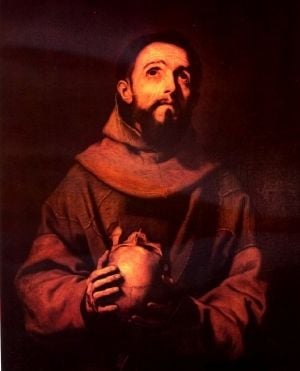
His earliest style, founded sometimes on Caravaggio and sometimes on the wholly diverse method of Correggio, can be traced to the study of Spanish and Venetian masters. Along with his massive and predominating shadows, he retained from first to last a great strength in local coloring. His forms, though ordinary and sometimes coarse, are correct; the impression of his works gloomy and startling.
Ribera's career in Naples is highlighted by several commissions for the monastic complex of Certosa di San Martino. Initially, from 1638 to 1643, he painted a series of prophets for the facade interior and side chapels of the church. Later, in 1651, he completed a large picture, the Communion of the Apostles, for the choir in the same church.[2]
In the early 1630s his style changed away from strong contrasts of dark and light to a more diffused and golden lighting. Salvator Rosa and Luca Giordano were his most distinguished followers, who may have been his pupils; others were also Giovanni Do, Enrico Fiammingo, Michelangelo Fracanzani, and Aniello Falcone.
Among Ribera's principal works are St. Januarius Emerging from the Furnace in the Cathedral of Naples; the Descent from the Cross in the Certosa, Naples, the Adoration of the Shepherds (a late work, 1650), now in the Louvre; the Martyrdom of St Bartholomew in the Prado; and the Pieta in the sacristy of San Martino, Naples. His mythologic subjects are often as violent as his martyrdoms, for example, Apollo and Marsyas, with versions in Brussels and Naples, or the Tityus in the Prado . The Prado and Louvre contain many of his paintings; the National Gallery, London, has three.
In his early Roman allegories of the five senses, his series of philosophers depicted as beggars or vagabonds (Archimedes, Prado, 1630) and his series on martyrs he created his own treatise on religious philosophy.
He executed several fine male portraits and a self-portrait. He was also an important etcher, the most significant Spanish printmaker before Goya, producing about forty prints, nearly all in the 1620s.
Gallery
Later life
From 1644, Ribera apparently became seriously ill, which greatly reduced his ability to work, although his workshop continued to produce. In 1647-1648, during the Masaniello rising against Spanish rule, he felt forced to take refuge with his family in the palace of the Viceroy for some months. In 1651 he sold the large house he had owned for many years, and when he died in July 1652 he was in serious financial difficulties.
Legacy
Although Ribera never returned to Spain, many of his paintings were taken back by returning members of the Spanish governing class, like the Duke of Osuna, and his etchings were brought to Spain by dealers. His influence can be seen in Diego Velázquez, Bartolomé Esteban Perez Murillo, and most other Spanish painters of the period.
In 1990 his 1634 painting, The Martyrdom of Saint Bartholomew, was purchased by the National Gallery in Washington, D.C. by the gallery's 50th Anniversary Committee. It sold at Sotheby's in London for 2.75 million pounds ($4.9 million).[3]
In 2005 his portrait Saint Andrew sold at Sotheby's for $1,192,000.[4]
Ribera's The Immaculate Conception traveled to Italy in 2005 to be included in the Vatican's exhibition, A Woman Dressed in Sun: Iconography of the Immaculate Conception. The exhibition was organized by the Roman Catholic Church's Pontifical Commission for Cultural Heritage in conjunction with the 150th anniversary of Pope Pius IX's 1854 proclamation of the Immaculate Conception—the dogma which states that Mary, the mother of Jesus, was free from original sin at the moment of her conception. Ribera's 9-by-6 foot painting depicts the Virgin Mary floating atop cumulous clouds and a host of cherubs and was one of 105 artworks included in the special Vatican exhibition. It was on loan from the Columbia Museum of Art in Columbia, South Carolina.[5]
Notes
- ↑ Melanie Heineman, Jusepe de Ribera: Saint Jerome Knox.edu. Retrieved January 28, 2008.
- ↑ Art of the Seventeenth and Eighteenth Centuries in Naples Metmuseum.org. Retrieved January 28, 2008.
- ↑ National Gallery's Ribera Gift Encyclopedia.com. Retrieved January 28, 2008.
- ↑ Important Old Master Paintings Thecityreview.com. Retrieved January 28, 2008.
- ↑ Homecoming of Artwork from the Vatican Carolinaarts.com. Retrieved January 28, 2008.
ReferencesISBN links support NWE through referral fees
- This article incorporates text from the Encyclopædia Britannica Eleventh Edition, a publication now in the public domain.
- Brown, Jonathan. 1973. Jusepe de Ribera: prints and drawings; [catalogue of an exhibition] The Art Museum, Princeton University, October-November 1973. Princeton, N.J.: Princeton University. OCLC 781367
- Perez Sanchez, Alfonso E., Nicola Spinosa, and Andrea Bayer. 1992. Jusepe de Ribera. New York: Metropolitan Museum of Art. ISBN 0870996479
- Ribera, José de. 1992. Jusepe de Ribera, 1591-1652. Napoli: Electa Napoli. ISBN 884353842X
- Scholz-Hänsel, Michael. 2000. Jusepe de Ribera, 1591-1652. Cologne: Könemann. ISBN 3829028725
- Spinosa, Nicola, Alfonso E. Perez Sanchez, Jonathan Brown, and Keith Christiansen. 2000. Ribera Yale University Press. ISBN 0300086628
- Williamson, Mark A. "The Martyrdom Paintings of Jusepe de Ribera: Catharsis and Transformation"; PhD Dissertation, Binghamton University, Binghamton, New York 2000.
External links
All Links Retrieved January 28, 2008.
- Biography of Ribera Spanisharts.com.
- Jusepe de Ribera Artcyclopedia.com.
- Jusepe de ribers Newadvent.org.
- Jusepe de Ribera Wga.hu.
- Hughes, Robert. 1992. Baroque Futurist Time.com.
- Heineman, Melanie. Jusepe de Ribera: Saint Jerome Knox.edu.
- Ribera Cgfa.sunsite.dk.
- 26 Prints and drawings from San Francisco Museums
Warning: Default sort key "Ribera, Giuseppe" overrides earlier default sort key "Ribera, Jusepe de".
Credits
New World Encyclopedia writers and editors rewrote and completed the Wikipedia article in accordance with New World Encyclopedia standards. This article abides by terms of the Creative Commons CC-by-sa 3.0 License (CC-by-sa), which may be used and disseminated with proper attribution. Credit is due under the terms of this license that can reference both the New World Encyclopedia contributors and the selfless volunteer contributors of the Wikimedia Foundation. To cite this article click here for a list of acceptable citing formats.The history of earlier contributions by wikipedians is accessible to researchers here:
The history of this article since it was imported to New World Encyclopedia:
Note: Some restrictions may apply to use of individual images which are separately licensed.
